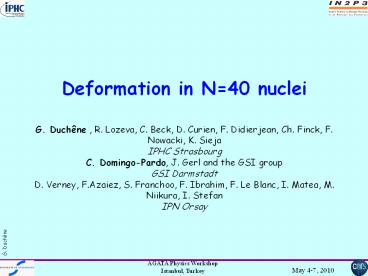Deformation in N=40 nuclei G. Duch - PowerPoint PPT Presentation
Title:
Deformation in N=40 nuclei G. Duch
Description:
Deformation in N=40 nuclei G. Duch ne , R. Lozeva, C. Beck, D. Curien, F. Didierjean, Ch. Finck, F. Nowacki, K. Sieja IPHC Strasbourg C. Domingo-Pardo, J. Gerl and ... – PowerPoint PPT presentation
Number of Views:100
Avg rating:3.0/5.0
Title: Deformation in N=40 nuclei G. Duch
1
Deformation in N40 nucleiG. Duchêne , R.
Lozeva, C. Beck, D. Curien, F. Didierjean, Ch.
Finck, F. Nowacki, K. SiejaIPHC StrasbourgC.
Domingo-Pardo, J. Gerl and the GSI groupGSI
DarmstadtD. Verney, F.Azaiez, S. Franchoo, F.
Ibrahim, F. Le Blanc, I. Matea, M. Niikura, I.
StefanIPN Orsay
2
Deformation in Fe and Cr nuclei
E. Caurier et al., Eur. Phys. J A15 (2002) 145
Fe
Cr
Cr
3
68Ni
K. Langanke et al., Phys. Rev. C67 (2003) 044314
- Is 68Ni a magic nucleus ?
- Increase of the 21 excitation energy
- Reduction of the B(E2) value
- No pronounced irregularity in the 2-neutron
separation energy - Strong 2p-2h component -gt excitation of a neutron
pair into g9/2 orbital - Major part of the B(E2) strength around 5 MeV
- Deformation in 68Ni
- 68Ni gs is spherical (Gaudefroy et al., Phys.
Rev. C80 (2009) 064313) - Main 01 state configuration is 4p-4h
- Does not generate much deformation
4
In the vicinity of 68Ni
- 67Co
- Collective 1p-2h proton intruder
- First excited ½- state with large quadrupole
deformation ß 0.25-0.4 - D. Pauwels et al., Phys. Rev. C 78, 041307(R)
(2009) - 69Cu
- Measured magnetic moment of 13/2 state
- Considerable proton excitations across the Z28
proton gap - Deviate from sphericity
- G. Georgiev et al., J. Phys. G Nucl. Part. Phys.
28, 2993 (2002) - 70Zn
- Given as a ?-soft nucleus (Gaudefroy et al.,
Phys. Rev. C80 (2009) 064313)
- Hunt for deformation with np-nh
- configurations (n6, 8) at higher
- excitation energy
5
Shell-model calculations
- Valence space
- 4020Ca20 core
- p f7/2 fp shell
- ? f7/2 frozen fp shell (p3/2 frozen) g9/2
d5/2 - 68Ni 8p-8h excitations
- 70Zn 6p-6h excitations
- Huge matrices to diagonalise
- (500 106)² to more than (109)²
- Several days calculation
- Results
- 68Ni 8p-8h config
- B(E2)down 690 e²fm4
- Q2 -49 e.fm²
- ß2 0.32
- E 13 MeV
- 6p-6h config
- B(E2)down 190 e²fm4
- Less deformation driving
- E 10 MeV
- 70Zn 6p-6h config
- B(E2)down 695 e²fm4
- Q2 -48 e.fm²
- ß2 0.32
- E 10 MeV
- All configurations are spread over many states
when configuration mixing is allowed !
6
Angular momentum and particle rates
- High-angular momentum states feeding
- Several nucleon knock-out lead to high-spin
transfers - 8 fed 10 time less than 2 state
- Hypothesis deformed structure feeding of 10 at
8 h - Nuclei production rate
- Primary beam 76Ge -gt Imax 3 108 p/s
- Primary Be/Nb target of 2.5 g/cm²
- Al degrader of 1.5 g/cm²
- Intermediate fragments 73Ga or 72Zn
- Rates calculations (slits cuts in S1, S3, S4)
105 Hz/wire
104 Hz
Lycca
AGATA
Primary beam (p/s) Intermediate fragment Trans mission S4 rate (p/s) Reaction Final nucleus Production rate (p/s)
7 106 p/s 7331Ga 30 104 fragmentation 6828Ni 0.3
7 106 p/s 7331Ga 30 104 1p-2n knock-out 7030Zn 18
3 107 p/s 7230Zn 42 104 fragmentation 6828Ni 2.5
3 107 p/s 7230Zn 42 104 2n knock-out 7030Zn 35
7
Gamma-ray statistics
- S2 geometry
- Full configuration 10TC 5DC -gt 17
- Min. configuration 5TC 3DC -gt 9
- Intermediate fragment 72Zn 1.5 MeV gamma ray
- Experiment duration 7 days
Projectile Nucleus of interest AGATA config. ?-rate (min-1) Total counts singles in 7 days ? ? -rate (min-1) Total counts doubles in 7 days
72Zn 68Ni 2.5 p/s Full 0.19 1900 0.024 244
72Zn 68Ni 2.5 p/s Min 0.10 1000 0.0068 69
72Zn 70Zn 35 p/s Full 2.66 26600 0.34 3400
72Zn 70Zn 35 p/s Min 1.40 14000 0.095 950
8
(No Transcript)
9
Ni-Zn-Ge
J. Van de Walle et al., Phys. Rev. Lett.99 (2007)
142501
Gaudefroy et al., Phys. Rev. C80 (2009) 064313
10
Tensor force
- Attractive between spin-flip orbitals
- Attractive interaction pf5/2-?d5/2
- Relaxed when removing protons from pf5/2 orbital
- Excitation energy of ?s1/2 state apparently
decreases vs ?d5/2 state
g7/2
s1/2
j1/2
d5/2
g9/2
p1/2
p3/2
j-1/2
f5/2
f7/2
p
?































